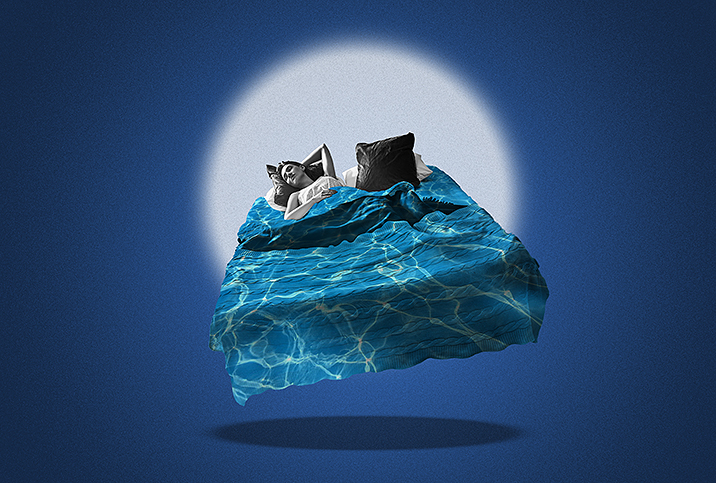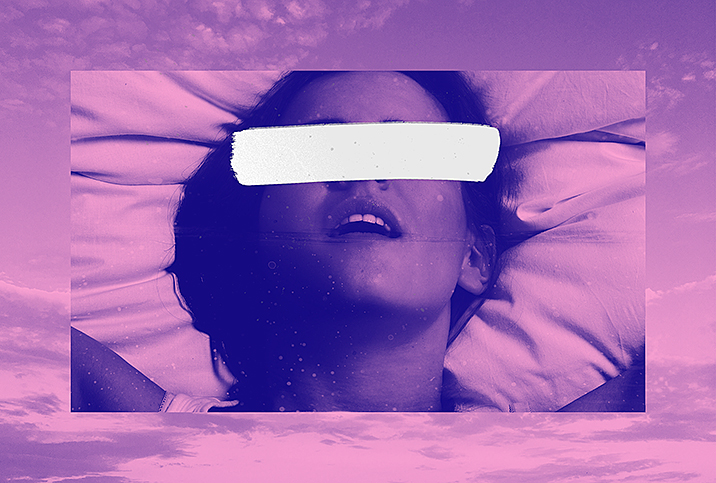Yes, You Can Still Have Wet Dreams Without a Penis

Wet dreams are thought of as a rite of passage for hormonal teenage boys in the throes of puberty, and if they’re shown at all in mainstream media, they’re usually depicted with a frenzied groan and a rush of embarrassment. Yet these sleepy secretions, known scientifically as "nocturnal emissions," are nothing to be ashamed of. They’re probably more common than you think––and a key, often-ignored fact is that you don’t need a penis to have one.
Evidence dates back to "The Hippocratic Corpus," a collection of medical texts produced in Ancient Greece. Buried among the dozens of stories of boned-up guys leaking semen in their sleep is one sole gynecological case: According to an article published in the Journal of History of Medicine and Medical Humanities in 2009, the woman’s “nocturnal emission” was treated as a “symptom of a dangerous illness.” Mythology spawned a more entertaining example in the form of Bastet, a sexed-up feline deity christened in a 2020 art exhibition as "The Goddess of Wet Dreams."
A few millennia later, extensive studies of nocturnal emissions experienced by women are still thin. Even in 2021, the most commonly referenced study comes from a 1986 article in the Journal of Sex Research, which summarized a few key statistics: “Thirty-seven percent of [women surveyed] reported they had experienced nocturnal orgasm, and 30 percent reported having had the experience in the past year.”
All of which raises a few questions: Why do we still almost exclusively associate wet dreams with dicks, and why is there so little research to dispel this myth?
A plausible explanation is that wet dreams look different for people with vaginas, making them harder to recognize. “While anyone can have an erotic dream, nocturnal emissions for men tend to have more obvious consequences,” explained Corey Babb, D.O., a Missouri-based gynecologist. “Conversely, since the vagina produces secretions throughout the day and night, the extra amount produced with an erotic dream may not be as fully noticeable upon awakening. Physiologically, the orgasm experience itself is no different––asleep or awake.”
Whether these sexy dreams result in just a little extra vaginal lubrication or a full-blown orgasm, they’re natural—and nothing to be afraid of.
As with nocturnal erections, a 1979 study published in the Journal of Sex & Marital Therapy found that vaginas also "undergo phasic shifts in vascular blood flow”––in other words, the clitoris engorges during sleep, specifically during the REM (rapid-eye movement) stages. This makes it easier to become aroused, so erotic dreams during these periods amp up the production of internal vaginal lubrication. These wet dreams don’t always end in orgasm, but as Babb explained, if they do, you’ll feel the same tingly rush as you would otherwise.
Medical research still lags when it comes to understanding the sexual health and pleasure of women, as well as women’s health more generally. A March commentary by Afton Vechery, CEO of reproductive health company Modern Fertility, argued that medical exclusion, cultural taboos and a lack of women in high-powered research positions all contribute to this ongoing problem, and as a result, women aren’t being given the information they need to fully understand their bodies.
“There’s definitely a lack of research, but what bothers me more is the lack of awareness,” said Maura Quinlan, M.D., a gynecologist at Northwestern Medicine. “I recently saw a young woman in her 20s who asked me to recommend lubricants, but as a young woman, you shouldn’t need them,” she recalled, incredulous. “The object of sex is that you both experience pleasure, so if you’re dry then, that’s on him.”
This medical and cultural sidelining of women’s sexual health has other consequences, too. “Sexual dysfunction in women is highly prevalent, and occurs in upwards of 40 percent of women in the United States alone,” Babb continued. “Other countries experience varying percentages, but overall the trend of women’s sexual health being a type of ‘taboo’ is just as common.” Despite this, Babb acknowledged that research is progressing over time, citing the International Society for the Study of Women’s Sexual Health as an exemplary organization working to fill these gaps in knowledge.
Some trans men and non-binary people also have vaginas, yet the painfully slow pace of trans-specific research means there’s little understanding of how hormones impact their bodies or what their wet dreams might look like. It’s well-known among trans communities that hormone replacement therapy (HRT) invokes various changes, known colloquially as a “second puberty,” and that these vary from person to person. A 2014 study published in the Journal of Sexual Medicine found that “71 percent of trans men reported an increase in sexual desire" after taking hormones, but there’s still little follow-up to clarify whether or not testosterone, which engorges the clitoris and increases sexual desire, results in a higher frequency of wet dreams, although horny forum entries in subreddits like r/ftm, a popular online space for trans men, suggest this could be the case.
Today, cultural understanding of the elusive vaginal wet dream is still largely guided by decades-old research and ancient myths of sexy, virile cat-goddesses, but all research points to the fact that they’re more common than we think. Whether these sexy dreams result in just a little extra vaginal lubrication or a full-blown orgasm, they’re natural—and nothing to be afraid of.


















